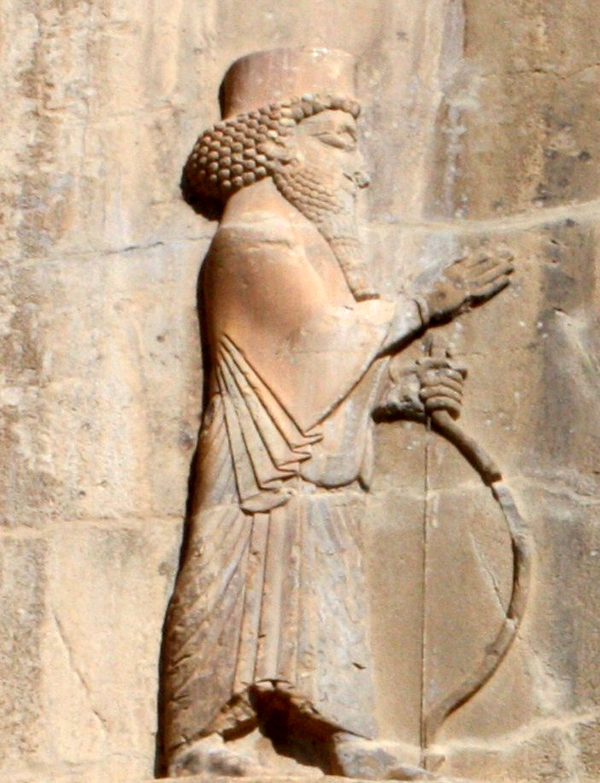 |
| Artaxerxes - Persian Emperors |
The Persian Empire reached its greatest strength under Darius I; under the reign of the three Artaxerxes it began and concluded its decline, ending with Alexander the Great’s conquests in 330 b.c.e. Artaxerxes I, third son of Emperor Xerxes I, acceded to the throne in 465 b.c.e. following the murder of his father and his brother Darius, who was first in line to the throne.
According to Josephus, the first century c.e. Jewish historian, Artaxerxes’ pre-throne name was Cyrus. The first century b.c.e. Roman historian Plutarch adds that he was nicknamed “long-armed” due to his right arm being longer than his left.
Earlier kings of the Persian Empire, namely Cyrus II, Darius, and Xerxes, were discussed in the comprehensive works of the near contemporary Greek historian Herodotus of Halicarnassus, but unfortunately Herodotus’s work did not cover much of Artaxerxes’ reign, and none of the reigns of later kings.
  |
Artaxerxes I
The Bible refers to Artaxerxes explicitly in Ezra 4:7, in reference to a letter written by the Jews’ enemies in Samaria. Both Ezra and Nehemiah, significant figures in the later history of the biblical Israelite people, arrived in Judah in Palestine to serve the Jews there during the reign of Artaxerxes.
If this is accurate then it was Artaxerxes for whom Nehemiah was cup bearer (Nehemiah 2:1), a position that gave him close access to the king, and it was to him that Nehemiah asked for permission to go to Jerusalem to oversee the rebuilding of the city walls.
A. T. Olmstead in A History of the Persian Empire
During his reign Artaxerxes generally followed the administrative practices of his father Xerxes. However, it was increasingly clear was that the empire, having reached its maximum extent under Darius I, Artaxerxes’ grandfather, was weakening.
Undoubtedly, a key cause was the high levels of taxation, which was stripping the satrapies, the regions of the empire, of gold and silver, enriching Persia’s vaults, but fostering discontent among the king’s subjects. In 460 ancient Egypt rebelled, drove out the Persian tax collectors, and requested aid from Athens. The Athenians, who were looking for a fight with Persia, sent a fleet; and by 459 nearly all of Egypt was in the hands of the rebel alliance.
It was probably in this turbulent period that Ezra made his application to Artaxerxes to allow a contingent of Jews to organize the worship of the returned exiles in Judaea. The Jews of Babylonia were probably some of the more loyal citizens, and since Persian policy supported organized religion, Ezra’s appeal met with sympathetic ears.
In the meantime Artaxerxes sent money to the Athenians’ Greek rival, Sparta, in order to counter their support of the Egyptian rebellion. Consequently, Athens was defeated at Tanagra (457), and with Judaea quieted, Artaxerxes sent his general Megabyzus at the head of a huge army down through the Levant to Egypt, taking back the country after one and a half years of siege.
 |
| Tomb of Artaxerxes I |
The resultant defeat left Athens severely weakened and demoralized. In 449 the Callian treaty was agreed between Athens and Persia in Susa, in which the parties accepted the maintenance of the status quo in Asia Minor, namely that those Greek city-states that were in either party’s control at the time of the treaty stayed under that party’s control.
A few years later the general Megabyzus resigned from the army and retired to the satrapy he governed, “The land beyond the River,” namely modern-day Israel, Lebanon, and Syria—and there led a revolt. Possibly it was the rebellious courage stirred up by Megabyzus’s actions that led local authorities to pull down the Jerusalem walls lest there be another uprising.
In 431 hostilities broke out between Athens and Sparta, thereby beginning the long Peloponnesian War. Artaxerxes decided to take a position of noninterference and made no effort to slow the course of events, ignoring the entreaties for support from both sides. Artaxerxes I died of natural causes toward the end of 424 b.c.e.
   |
Artaxerxes II
Artaxerxes II, the grandson of Artaxerxes I, acceded to the throne in March 404 b.c.e. on the death of his father, Darius II. However, the following year his younger brother Cyrus began plotting his overthrow. Cyrus gathered an army, significantly including 10,000 Greek mercenaries, and marched east.
Finally battle was drawn in 401 against his brother’s army at Cunaxa in central Mesopotamia, but despite initial success on Cyrus’s part, his rashness led to a crucial mistake that resulted in his death, and Artaxerxes won the day.
This not withstanding, the Greek mercenaries were allowed to march the thousand miles home, Artaxerxes not wanting to tackle them. This “March of the Ten Thousand
In 396 Sparta began a new war to take back control of the Greek cities of Asia Minor. While the Spartans played off one Persian satrap against another, Artaxerxes, aware of the empire’s military weakness, used its vast wealth to buy an alliance with Athens, Sparta’s local rival.
The Athenians aided the strengthened Persian navy, successfully countering the Spartan threat, with the result that in 387–386 a peace was struck, which once again required Sparta to give up any claims to sovereignty over the Greek cities in Asia Minor.
In 405 Egypt had revolted and remained independent from Persia throughout most of Artaxerxes’ reign. In 374 Artaxerxes sent a force to retake Egypt. The attempt failed, reinforcing the impression that the central authority was weakening. With rebellion rife the situation seemed to be slipping out of control and auguring the end of the empire.
However, the rebels’ Egyptian ally, Pharaoh Nekhtenebef, died unexpectedly in 360, leaving Egypt in chaos and the satraps of Asia Minor to face the wrath of the emperor alone. Rather than risk losing to the central authority, the rebels made peace with Artaxerxes, and many were in fact returned to their satrapies.
Artaxerxes III
 |
| Artaxerxes III of Persia |
In 358 b.c.e., after a long and moderately successful tenure, though rife with revolts, Artaxerxes II died. His son Ochus acceded to the throne taking the name Artaxerxes III.
Ochus’s bloodthirsty reputation—possibly the worst in this regard of any of the Achaemenid kings—was compounded by the murder of all his relations, regardless of sex or age, soon after his accession. However, his ruthless ferocity did not stop revolts from rocking the empire.
Ochus made a fresh attempt to take back Egypt in 351 but was repulsed, and this encouraged further rebellions in the western satrapies. In 339 Persia misplayed its hand with Athens by refusing Athenian aid to deal with the rising power of Philip of Macedon. Persia took on Philip alone but failed to defeat him, and in 338 Philip took overlordship of the whole of Greece.
Greece united under Philip proved impervious to Persian might, and within eight years Persepolis, the Persian royal capital and the whole empire, was to collapse at the hands of Philip’s son, Alexander the Great.
Ochus’s physician, at the command of the powerful eunuch Bagoas, murdered Ochus, and Bagoas made Ochus’s youngest son, Arses, king (338–336 b.c.e.). Arses attempted to kill the too powerful Bagoas and was killed, allowing Darius III to become king. Darius survived until his death in 330 b.c.e. at the hands of Alexander.
